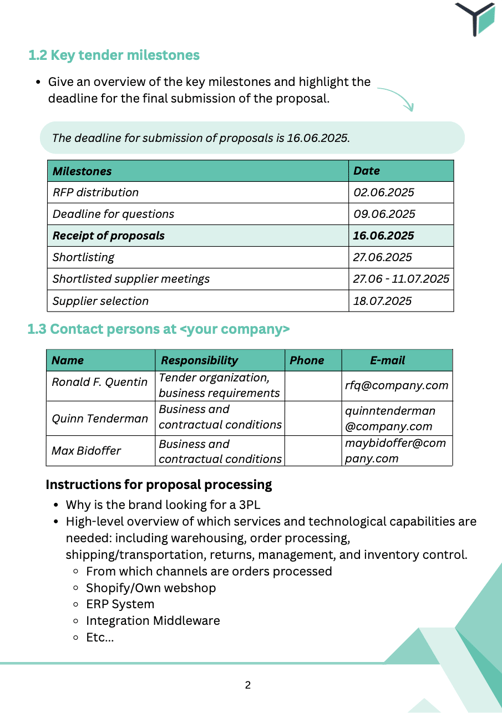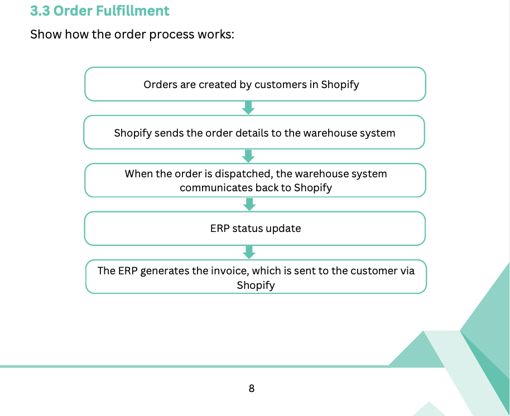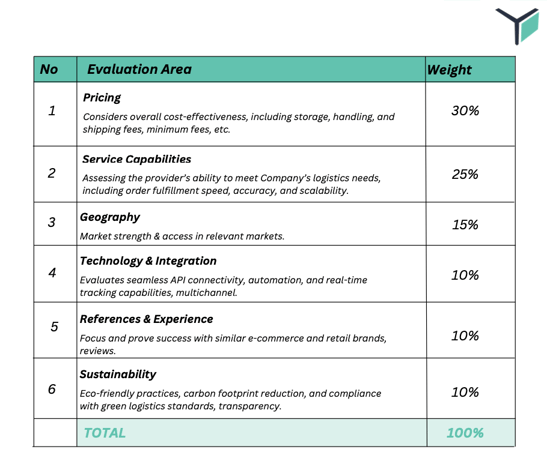Mastering RFPs and RFQs in European E-Commerce Logistics
Table of Content
If you’re working in a fast-growing or established e-commerce business, you know that scaling your supply chain is crucial to staying competitive. To take your logistics operations to the next level, finding the right 3PL partner through a structured Request for Proposal (RFP) or Request for Quotation (RFQ) process is essential.
This guide will help you navigate that process with clarity by offering a straightforward overview, practical tips, and a downloadable template to get you started.
|
A Real-World Scenario Consider Anna, head of supply chain for an online cosmetics retailer based in Germany. Her company is experiencing rapid growth and wants to enter the UK market with a reliable fulfillment partner in the UK. Faced with the complexities of multi-country fulfillment, Anna needs a partner who can offer reliable warehousing, efficient cross-border delivery, and full integration with her ERP system. Anna begins by crafting a detailed RFP outlining her objectives, namely scaling operations, meeting increased seasonal demand, and ensuring compliance with local regulations. She specifies operational details such as average order volume, storage requirements, and technology needs. After receiving several proposals, she narrows her options and issues an RFQ to get precise cost details on the shortlisted 3PLs. This structured approach allows Anna to compare service quality and pricing transparently, ultimately leading her to a partner who meets her strategic and operational needs. |
Understanding the Basics: RFP vs. RFQ
Before diving into the details, let’s clarify the two most critical documents in logistics procurement:
What is a Request for Proposal (RFP)?
An RFP is your invitation for 3PLs to propose customized solutions. It’s used when your fulfillment needs are complex. Think tailored warehousing solutions, technology integration, and specialized distribution channels. An RFP provides room for creativity and strategic alignment.
What is a Request for Quotation (RFQ)?
An RFQ is more focused and transactional. Use it when your requirements are clear-cut, and you’re primarily looking for competitive pricing for standardized services. For example, if you need specific shipping rates or fulfillment fees, an RFQ is your go-to tool.
Your Situation: We Understand the Challenge
Imagine this: You’ve recently expanded your e-commerce business into new European markets. With increased order volumes and complex logistics, you’re feeling the pressure to choose the right 3PL partner, one that can handle cross-border shipping, manage localized compliance issues, and integrate with your existing systems. You’re likely overwhelmed by the technical details and uncertain about where to start with your RFP or RFQ. You need a clear, step-by-step process that demystifies these documents and helps you secure a fulfillment partner who can help you scale your business.
Step-by-Step Guide to Creating Your RFP/RFQ
1. Cover Page and Introduction
Purpose:
The cover page is your first impression. It should ideally present your company’s logo, name, and the document’s title. Emphasize confidentiality to set the stage for a secure procurement process.
- Elements to Include:
- Your company’s logo and name.
- Title: “Request for Proposal for Third-Party Logistics Partner.”
- Basic company information (address, commercial registration, etc.).
| Tip: Ensure your cover page design is clean and professional to reflect the seriousness and credibility of your business. |

2. Basic Company Information & Tender Overview
Objective:
Provide a concise background about your company and outline the tender’s context. This section sets the tone by clarifying who you are and why you’re seeking a 3PL partner.
- Key Components:
-
- About Your Company:
- A brief overview highlighting your e-commerce operations, market presence, and growth objectives.
- A brief overview highlighting your e-commerce operations, market presence, and growth objectives.
- Instructions for Proposal Submission:
- Format (e.g., PDF, Excel, presentation).
- Currency and language.
- Submission contact details.
- Key Tender Milestones:
-
- Timeline including deadlines for questions, proposal submissions, evaluations, and final selection.
- Timeline including deadlines for questions, proposal submissions, evaluations, and final selection.
-
- Contact Persons:
-
- Provide names, responsibilities, phone numbers, and email addresses of the key contacts handling the RFP process.
-
- About Your Company:
Example Scenario:
Imagine you are expanding into new European markets and need a partner who understands local regulations and can scale with seasonal demand. Clear tender information builds trust and sets expectations from the start.

3. Introduction & Background
Objective:
Explain why you are initiating the RFP and what you expect from a future 3PL partner.
Key Points:
- Why does your brand need a 3PL (e.g., handling increased order volumes, improving cross-border logistics, integrating new e-commerce technologies).
- Overview of required services, including warehousing, order processing, shipping/transportation, returns, and inventory control.
- Mention the key systems you use (e.g., Shopify, marketplaces, ERP, integration middleware) to underline your operational context.
4. RFP Objectives
Objective:
Clearly articulate the main goals and selection criteria for your 3PL partner. This section tells fulfillment companies exactly what matters to your business.
- Exemplary Primary Objectives:
- Scalability & Flexibility: Ability to support international expansion and manage seasonal peaks.
- Cost Efficiency: Competitive pricing for storage, handling, and shipping.
- Technology Integration: Seamless API connectivity with systems like Shopify and ERP.
- Service Excellence: Fast and accurate order fulfillment, robust returns management.
- Sustainability: Commitment to eco-friendly logistics practices and packaging solutions.
Actionable Tip: List your objectives as bullet points so 3PLs can quickly assess whether they meet your criteria.
5. Detailed Scope of Services
Objective:
Break down the specific services you require. This section must be comprehensive to ensure potential logistics partners understand every aspect of your operational needs.
5.1 Inbound Logistics
- Delivery Notifications:
- Define lead times (e.g., “Deliveries will be notified 3-5 days in advance”).
- Detail what information will be included in notifications (supplier name, reference number, quantity, etc.).
- Goods Delivery Specifications:
- Explain the packaging (pre-packed boxes, retail boxes, SKUs), labeling (EAN codes), and pallet specifications.
- Inspection & Documentation:
- Outline requirements for quality verification (e.g., random audits, spot checks).
- Documentation of announced delivery vs. actual delivery
5.2 Warehousing & Inventory Management
- Operational Requirements:
- Real-time tracking requirements, picking processes (FIFO, LOT allocation), and warehouse specifications (location, safety standards, capacity).
- Storage Requirements:
- Detail the type and volume of storage needed (e.g., number of EURO pallets, total SKUs).
5.3 Order Fulfillment
- Process Overview:
- Describe the order-to-delivery process, payment options (because options like Cash-on-Delivery can impact logistical requirements), and packaging instructions (include visual support if possible).
- Special Conditions:
- Handling seasonal promotions, product bundling, and branded packaging for first-time customers.
5.4 Shipping & Last-Mile Delivery
- Cut-Off Times & Delivery Methods:
- List required cut-off times, delivery methods, and expected delivery delays.
- Weight and Destination Details:
- Include average parcel weights and delivery volumes by country.
5.5 B2B Fulfillment (if applicable)
- Requirements for B2B Orders:
- Order volume, order type (parcels vs. pallets), packaging requirements, and typical order structure.
5.6 Returns & Reverse Logistics
- Returns Processing:
- Define the process for initiating returns, processing times, quality checks, and status updates.
- Documentation and System Updates:
- Requirements for inventory adjustments and documentation (e.g., including photographs of returned items).
5.7 Inventory Audit
- Audit Requirements:
- Specify frequency and methods for inventory checks and yearly stock counts.

6. Technology & Integration
Objective:
Detail the technological capabilities required to support seamless operations and real-time data tracking.
- Key Requirements can include:
- Integration with your e-commerce, ERP, and marketplace systems.
- Real-time data insights and reporting capabilities.
- Batch/LOT tracking, serial number tracking, and bundle creation.
- Re-order point notifications and address validation systems.
| Tip: Provide examples of current systems and data points you rely on, so fulfillment companies understand your digital ecosystem. |
7. Service Level Agreements (SLAs)
Objective:
Define the performance metrics and benchmarks you expect from your 3PL partner.
- Include:
- Inbound and outbound processing times.
- Accuracy rates for order fulfillment.
- Expected response times for issue resolution.
- Penalties for non-compliance or service failures.
8. Sustainability & ESG
Objective:
If applicable, highlight your commitment to sustainable practices and require vendors to meet similar standards.
- Key Points:
- Eco-friendly packaging solutions.
- Certifications and climate-friendly shipping options.
- Sustainability initiatives that align with your corporate ESG strategy.
9. Expertise & Experience
Objective:
Ensure that your logistics partner has the necessary experience and can provide relevant references.
- Ask For:
- Case studies or examples of similar projects.
- References from businesses in the same industry or with similar operational needs.
- Information on relevant certifications and quality standards (e.g., HACCP, ISO).
10. Cost Structure & Pricing Model
Objective:
Clarify what pricing details you need to compare 3PLs effectively.
- Cost Elements to Cover:
- Onboarding and integration fees.
- Storage, handling, and fulfillment costs.
- Shipping and additional service fees.
- Volume discounts and payment terms.
11. Evaluation Criteria
Objective:
Explain how you will evaluate and select the winning proposal. This transparency helps fulfillment companies to tailor their responses effectively.
- Criteria May Include:
- Overall pricing and cost-effectiveness.
- Service capabilities (SLAs, scalability, and flexibility).
- Technological integration and data reporting capabilities.
- Relevant experience and quality of references.
- Sustainability initiatives and overall value-added services.

12. General Provisions
Objective:
Lay out the formal terms and conditions under which the RFP is issued.
- Key Provisions:
- Purpose & Non-Binding Nature:
Clearly state that the RFP does not commit your company to any contract. - Cost Responsibilities:
Clarify that 3PLs cover their own proposal costs. - Changes & Timeline:
Reserve the right to modify or cancel the RFP process. - Questions & Communication Rules:
Define how logistics companies can submit queries and how official communications will be handled. - Reference Checks & Site Visits:
Mention that site visits or additional evaluations may be requested. - Confidentiality & Compliance:
Stress that all proposals are confidential and that any breach could result in disqualification. - Disqualification Clause:
Outline conditions that could disqualify a vendor from the process.
Download Your Free 3PL RFP Template
Are you ready to simplify your procurement process? Download our customizable 3PL RFP template designed specifically for European e-commerce companies. This template walks you through every step - from defining your objectives to evaluating vendor responses - so you can confidently select a partner that fits your needs.
Conclusion
Creating a comprehensive 3PL RFP tailored for European e-commerce logistics involves clarity, detailed requirements, and transparency in expectations. By following this step-by-step guide, you’ll be able to articulate your operational needs effectively, compare proposals accurately, and select a partner who aligns with your strategic goals.